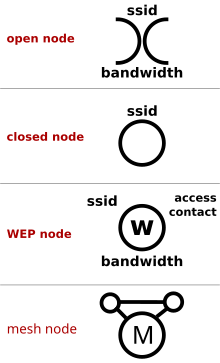
Warchalking is the drawing of symbols in public places to advertise an open Wi-Fi network. Inspired by hobo symbols, the warchalking marks were conceived by a group of friends in June 2002 and publicised by Matt Jones who designed the set of icons and produced a downloadable document containing them. Within days of Jones publishing a blog entry about warchalking, articles appeared in dozens of publications and stories appeared on several major television news programs around the world.
The word is formed by analogy to wardriving, the practice of driving around an area in a car to detect open Wi-Fi nodes. That term in turn is based on wardialing, the practice of dialing many phone numbers hoping to find a modem.

Having found a Wi-Fi node, the warchalker draws a special symbol on a nearby object, such as a wall, the pavement, or a lamp post. Those offering Wi-Fi service might also draw such a symbol to advertise the availability of their Wi-Fi location, whether commercial or personal.
| This section needs expansion with: Cites establishing either A) warchalking was actually used in the field, or B) the opposite. If it was never actually used, this article may be miscategorized. You can help by adding to it. (June 2013) |
References
- "Let's Warchalk" (PDF). Matt Jones. Archived from the original (PDF) on 2008-07-05. Retrieved 2008-10-09.
- ^ "Chalk points to wireless internet". BBC. 2002-07-22. Retrieved 2008-10-09.
- "Welcome to the era of drive-by hacking". BBC. 2001-11-06. Retrieved 2008-10-09.
- Clyde, Laurel A. (2003). "Wi-fi and Warchalking". Teacher Librarian. 31: 44–46.
External links
- Langley, Nick (23 June 2003). "The demise of the warchalkers". ComputerWeekly. Archived from the original on 2017-12-22. Retrieved 10 May 2017.